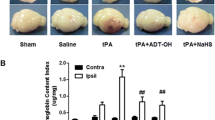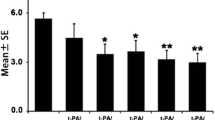Abstract
Spontaneous intracerebral hemorrhage (ICH) represents a partially-understood cerebrovascular disease of high incidence, morbidity and mortality. We, herein, report the findings of our study concerning the role of two important adenosinetriphosphatases (ATPases) in a porcine model of spontaneous ICH that we have recently developed (by following recent references as well as previously-established models and techniques), with a focus on the first 4 and 24 h following the lesion’s induction, in combination with a study of the effectiveness of the lazaroid antioxidant U-74389G administration. Our study demonstrates that the examined ICH model does not cause a decrease in Na+,K+-ATPase activity (the levels of which are responsible for a very large part of neuronal energy expenditure) in the perihematomal basal ganglia territory, nor a change in the activity of Mg2+-ATPase. This is the first report focusing on these crucial ATPases in the experimental setting of ICH and differs from the majority of the findings concerning the behavior of these (crucial for central nervous system cell survival) enzymes under stroke-related ischemic conditions. The administration of U-74389G (an established antioxidant) in this ICH model revealed an injury specific type of behavior, that could be considered as neuroprotective provided that one considers that Na+,K+- and Mg2+-ATPase inhibition might in this case diminish the local ATP consumption.


Similar content being viewed by others
References
Aronowski J, Zhao X (2011) Molecular pathophysiology of cerebral hemorrhage: secondary brain injury. Stroke 42:1781–1786
Astrup J (1982) Energy-requiring cell functions in the ischemic brain. Their critical supply and possible inhibition in protective therapy. J Neurosurg 56:482–497
Bimpis A, Papalois A, Tsakiris S, Zarros A, Kalafatakis K, Botis J, Stolakis V, Zissis KM, Liapi C (2012) Activation of acetylcholinesterase after U-74389G administration in a porcine model of intracerebral hemorrhage. Metab Brain Dis 27:221–225
Bogdanski DF, Tissari A, Brodie BB (1968) Role of sodium, potassium, ouabain and reserpine in uptake, storage and metabolism of biogenic amines in synaptosomes. Life Sci 7:419–428
Bowler K, Tirri R (1974) The temperature characteristics of synaptic membrane ATPases from immature and adult rat brain. J Neurochem 23:611–613
Broderick J, Brott T, Tomsick T, Tew J, Duldner J, Huster G (1994) Management of intracerebral hemorrhage in a large metropolitan population. Neurosurgery 34:882–887
Cannon JR, Xi G, Keep RF (2007) Recent research on changes in genomic regulation and protein expression in intracerebral haemorrhage. Int J Stroke 2:265–269
Chen CM, Liu SH, Lin-Shiau SY (2007) Honokiol, a neuroprotectant against mouse cerebral ischaemia, mediated by preserving Na+, K+ -ATPase activity and mitochondrial functions. Basic Clin Pharmacol Toxicol 101:108–116
Chen RJ, Jinn TR, Chen YC, Chung TY, Yang WH, Tzen JT (2011) Active ingredients in Chinese medicines promoting blood circulation as Na+/K+-ATPase inhibitors. Acta Pharmacol Sin 32:141–151
Cho SO, Ban JY, Kim JY, Ju HS, Lee IS, Song KS, Bae K, Seong YH (2009) Anti-ischemic activities of Aralia cordata and its active component, oleanolic acid. Arch Pharm Res 32:923–932
Clausen T, Van Hardeveld C, Everts ME (1991) Significance of cation transport in control of energy metabolism and thermogenesis. Physiol Rev 71:733–774
Djuričić BM, Mićić DV, Mršulja BB (1984) Phasic recognition of edema caused by ischemia. In: Go KG, Baethmann A (eds) Recent progress in the study and therapy of brain edema. Plenum Press, New York, pp 491–498
Douglas HA, Callaway JK, Sword J, Kirov SA, Andrew RD (2011) Potent inhibition of anoxic depolarization by the sodium channel blocker dibucaine. J Neurophysiol 105:1482–1494
Durmaz R, Kanbak G, Akyüz F, Isiksoy S, Yücel F, Inal M, Tel E (2003) Lazaroid attenuates edema by stabilizing ATPase in the traumatized rat brain. Can J Neurol Sci 30:143–149
Félix B, Léger ME, Albe-Fessard D, Marcilloux JC, Rampin O, Laplace JP (1999) Stereotaxic atlas of the pig brain. Brain Res Bull 49:1–137
Gregson BA, Broderick JP, Auer LM, Batjer H, Chen XC, Juvela S, Morgenstern LB, Pantazis GC, Teernstra OP, Wang WZ, Zuccarello M, Mendelow AD (2012) Individual patient data subgroup meta-analysis of surgery for spontaneous supratentorial intracerebral hemorrhage. Stroke 43:1496–1504
Hall ED, McCall JM, Means ED (1994) Therapeutic potential of the lazaroids (21-aminosteroids) in acute central nervous system trauma, ischemia and subarachnoid hemorrhage. Adv Pharmacol 28:221–268
Hernández J (1987) Brain Na+, K+ -ATPase activity possibly regulated by a specific serotonin receptor. Brain Res 408:399–402
James JH, Fang CH, Schrantz SJ, Hasselgren PO, Paul RJ, Fischer JE (1996) Linkage of aerobic glycolysis to sodium-potassium transport in rat skeletal muscle. Implications for increased muscle lactate production in sepsis. J Clin Invest 98:2388–2397
Jung YW, Choi IJ, Kwon TH (2007) Altered expression of sodium transporters in ischemic penumbra after focal cerebral ischemia in rats. Neurosci Res 59:152–159
Katsuki H (2010) Exploring neuroprotective drug therapies for intracerebral hemorrhage. J Pharmacol Sci 114:366–378
Kawai N, McCarron RM, Spatz M (1996) Effect of hypoxia on Na+-K+-Cl- cotransport in cultured brain capillary endothelial cells of the rat. J Neurochem 66:2572–2579
Keller JN, Germeyer A, Begley JG, Mattson MP (1997) 17Beta-estradiol attenuates oxidative impairment of synaptic Na+/K+-ATPase activity, glucose transport, and glutamate transport induced by amyloid beta-peptide and iron. J Neurosci Res 50:522–530
Linn F, Seo K, Hossmann KA (1989) Experimental transplantation gliomas in the adult cat brain. 3. Regional biochemistry. Acta Neurochir (Wien) 99:85–93
Lowry OH, Rosebrough NJ, Farr AL, Randall RJ (1951) Protein measurement with the Folin phenol reagent. J Biol Chem 193:265–275
Mata M, Fink DJ, Gainer H, Smith CB, Davidsen L, Savaki H, Schwartz WJ, Sokoloff L (1980) Activity-dependent energy metabolism in rat posterior pituitary primarily reflects sodium pump activity. J Neurochem 34:213–215
Mendelow AD, Gregson BA, Fernandes HM, Murray GD, Teasdale GM, Hope DT, Karimi A, Shaw MD, Barer DH, STICH investigators (2005) Early surgery versus initial conservative treatment in patients with spontaneous supratentorial intracerebral haematomas in the International Surgical Trial in Intracerebral Haemorrhage (STICH): a randomised trial. Lancet 365:387–397
Moro MA, Almeida A, Bolaños JP, Lizasoain I (2005) Mitochondrial respiratory chain and free radical generation in stroke. Free Radic Biol Med 39:1291–1304
Mrsulja BB, Djuricić BM, Cvejić V, Mrsulja BJ, Abe K, Spatz M, Klatzo I (1980) Biochemistry of experimental ischemic brain edema. Adv Neurol 28:217–230
Nakamura T, Keep RF, Hua Y, Hoff JT, Xi G (2005) Oxidative DNA injury after experimental intracerebral hemorrhage. Brain Res 1039:30–36
Okada Y, Kloiber O, Hossmann KA (1992) Regional metabolism in experimental brain tumors in cats: relationship with acid/base, water, and electrolyte homeostasis. J Neurosurg 77:917–926
Oselkin M, Tian D, Bergold PJ (2010) Low-dose cardiotonic steroids increase sodium-potassium ATPase activity that protects hippocampal slice cultures from experimental ischemia. Neurosci Lett 473:67–71
Paul RJ, Bauer M, Pease W (1979) Vascular smooth muscle: aerobic glycolysis linked to sodium and potassium transport processes. Science 206:1414–1416
Qureshi AI, Mendelow AD, Hanley DF (2009) Intracerebral haemorrhage. Lancet 373:1632–1644
Rodríguez-Yáñez M, Castellanos M, Freijo MM, López Fernández JC, Martí-Fàbregas J, Nombela F, Simal P, Castillo J; por el Comitéad hoc del Grupo de Estudio de Enfermedades Cerebrovasculares de la SEN, Díez-Tejedor E, Fuentes B, Alonso de Leciñana M, Alvarez-Sabin J, Arenillas J, Calleja S, Casado I, Dávalos A, Díaz-Otero F, Egido JA, Gállego J, García Pastor A, Gil-Núñez A, Gilo F, Irimia P, Lago A, Maestre J, Masjuan J, Martínez-Sánchez P, Martínez-Vila E, Molina C, Morales A, Purroy F, Ribó M, Roquer J, Rubio F, Segura T, Serena J,Tejada J, Vivancos J (2011) Clinical practice guidelines in intracerebral haemorrhage. Neurologia; Epub ahead of print
Santos MS, Moreno AJ, Carvalho AP (1996) Relationships between ATP depletion, membrane potential, and the release of neurotransmitters in rat nerve terminals. An in vitro study under conditions that mimic anoxia, hypoglycemia, and ischemia. Stroke 27:941–950
Sanui H, Rubin H (1982) The role of magnesium in cell proliferation and transformation. In: Boynton AL, McKochan WL, Whitfield JP (eds) Ions, cell proliferation and cancer. Academic, New York, pp 517–537
Sastry BS, Phillis JW (1977) Antagonism of biogenic amine-induced depression of cerebral cortical neurones by Na+, K+ -ATPase in inhibitors. Can J Physiol Pharmacol 55:170–179
Shigeno T, Asano T, Mima T, Takakura K (1989) Effect of enhanced capillary activity on the blood–brain barrier during focal cerebral ischemia in cats. Stroke 20:1260–1266
Swann AC (1984) (Na+, K+)-adenosine triphosphatase regulation by the sympathetic nervous system: effects of noradrenergic stimulation and lesions in vivo. J Pharmacol Exp Ther 228:304–311
Tsakiris S (2001) Effects of L-phenylalanine on acetylcholinesterase and Na+, K+ -ATPase activities in adult and aged rat brain. Mech Ageing Dev 122:491–501
van Asch CJ, Luitse MJ, Rinkel GJ, van der Tweel I, Algra A, Klijn CJ (2010) Incidence, case fatality, and functional outcome of intracerebral haemorrhage over time, according to age, sex, and ethnic origin: a systematic review and meta-analysis. Lancet Neurol 9:167–176
Wagner KR (2007) Modeling intracerebral hemorrhage: glutamate, nuclear factor-kappa B signaling and cytokines. Stroke 38(2 Suppl):753–758
Wagner KR, Xi G, Hua Y, Kleinholz M, de Courten-Myers GM, Myers RE, Broderick JP, Brott TG (1996) Lobar intracerebral hemorrhage model in pigs: rapid edema development in perihematomal white matter. Stroke 27:490–497
Wagner KR, Xi G, Hua Y, Kleinholz M, de Courten-Myers GM, Myers RE (1998) Early metabolic alterations in edematous perihematomal brain regions following experimental intracerebral hemorrhage. J Neurosurg 88:1058–1065
Wagner KR, Sharp FR, Ardizzone TD, Lu A, Clark JF (2003) Heme and iron metabolism: role in cerebral hemorrhage. J Cereb Blood Flow Metab 23:629–652
Wang JK, Portbury S, Thomas MB, Barney S, Ricca DJ, Morris DL, Warner DS, Lo DC (2006) Cardiac glycosides provide neuroprotection against ischemic stroke: discovery by a brain slice-based compound screening platform. Proc Natl Acad Sci USA 103:10461–10466
White SH, Brisson CD, Andrew RD (2012) Examining protection from anoxic depolarization by the drugs dibucaine and carbetapentane using whole cell recording from CA1 neurons. J Neurophysiol 107:2083–2095
Yang Y, Zhang XJ, Yin J, Li LT (2008) Brain damage related to hemorrhagic transformation following cerebral ischemia and the role of KATP channels. Brain Res 1241:168–175
Zhan C, Yang J (2006) Protective effects of isoliquiritigenin in transient middle cerebral artery occlusion-induced focal cerebral ischemia in rats. Pharmacol Res 53:303–309
Zhu HL, Luo WQ, Wang H (2008) Iptakalim protects against hypoxic brain injury through multiple pathways associated with ATP-sensitive potassium channels. Neuroscience 157:884–894
Acknowledgments
The authors would like to acknowledge their appreciation to Mr Vasileios Stolakis (BSc, MSc) for his technical assistance. This work was supported by the Experimental - Research Center ELPEN and the Medical School of the National and Kapodistrian University of Athens. The authors declare that no conflict of interest exists.
Author information
Authors and Affiliations
Corresponding author
Additional information
Alexios Bimpis and Apostolos Papalois contributed equally to the study.
Rights and permissions
About this article
Cite this article
Bimpis, A., Papalois, A., Tsakiris, S. et al. Modulation of crucial adenosinetriphosphatase activities due to U-74389G administration in a porcine model of intracerebral hemorrhage. Metab Brain Dis 28, 439–446 (2013). https://doi.org/10.1007/s11011-013-9380-8
Received:
Accepted:
Published:
Issue Date:
DOI: https://doi.org/10.1007/s11011-013-9380-8




